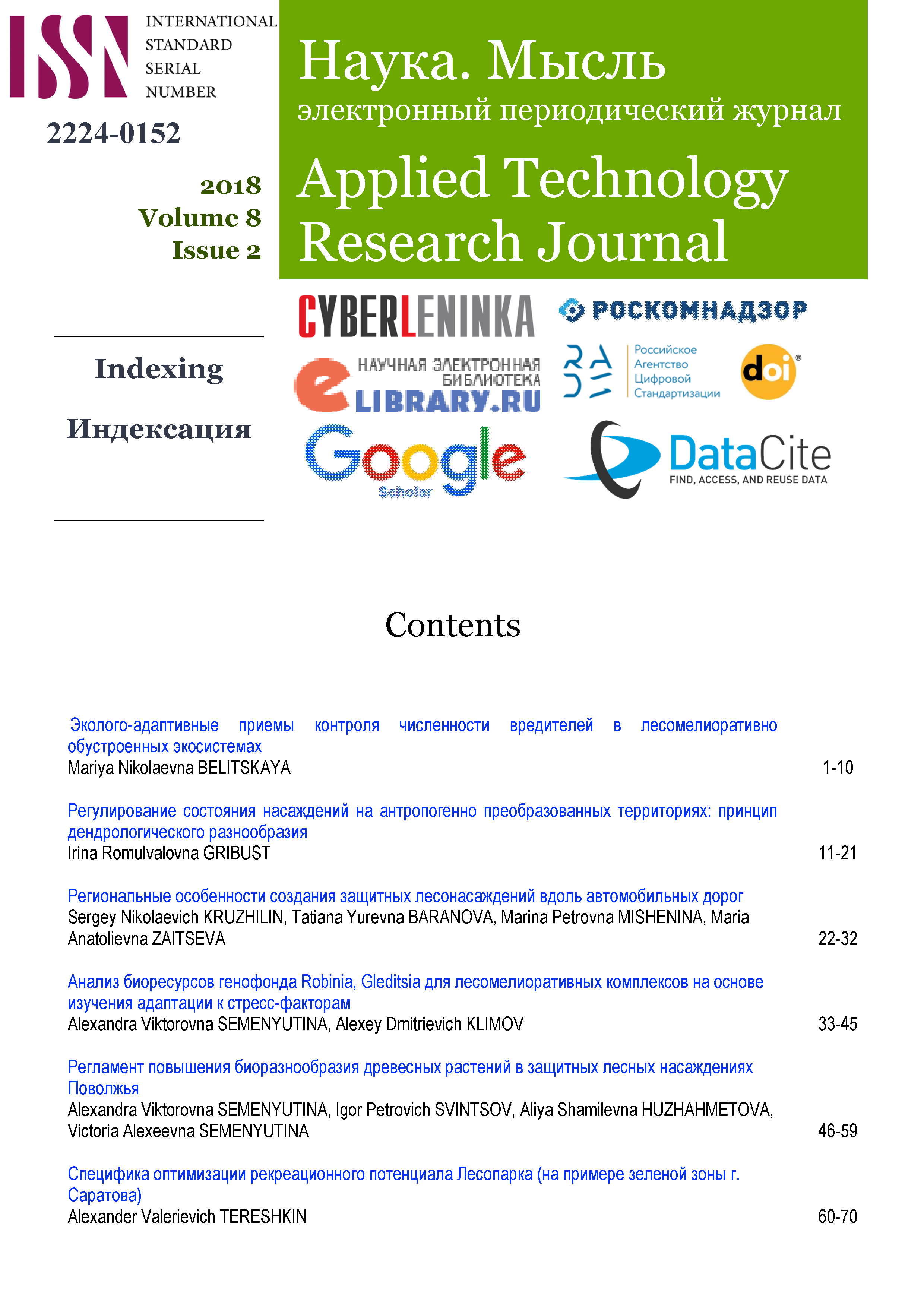Analysis of bioresources of the gene pool of Robinia, Gleditsia for forest meliorative complexes on the basis of studying adaptation to stress factors
DOI:
https://doi.org/10.25726/NM.2018.2.2.004Keywords:
adaptation, growth, seasonal development, biodiversity, species, forms, Robinia, Gleditsia, tolerance, stress factors, landscaping, protective afforestation, enrichmentAbstract
The economically valuable gene pool of species and form diversity of Robinia L. and Gleditsia L. is of interest for the degraded landscapes of the arid region. In gardening and forest melioration in the south of the country, only one type of Gleditsia (Gleditsia triacanthos L.) and one species of Robinia (Robinia pseudoacacia L.) are widely used.
The objects of the study were representatives of the genera Robinia (R. viscosa Vent., R. luxurians (Dieck) S.K. Schneid., R. pseudoacacia L., R. pseudoacacia L. f. pyramidalis (Pepin) Rehd., R. pseudoacacia L. f. unifoliola (Talou) Rehd., R. pseudoacacia L. f. umbraculifera (DC) Rehd.) and Gleditsia (G. triacanthos L., G. triacanthos L f. inermis, G. aquatica Marsh, G. caspica Desf, G. sinensis Lam., G. texana Sarg., G. japonica Miq.) from different floristic regions to the conditions of the Volgograd region (FNC of agroecology RAS, cadast No. 34: 34: 000000: 122, 34: 34: 060061: 10; Nizhnevolzhskaya station on selection of wood species, No. 34: 36: 0000: 14: 0178).
It has been revealed that the adaptation of the gene pool of Robinia, Gleditsia to stress factors is important in the Volga regions, where droughts, high and low temperatures manifest themselves as stressors. To determine the tolerance of the species and form diversity of Robinia, Gleditsia, the specificity of their growth and development has been established according to the degree of adaptation in conditions of introduction based on long-term studies. The research was carried out on the following indicators: growth, seasonal development, attitude to stress factors, ecology of flowering and fruiting.
A comparative assessment of quantitative measurements of chlorophyll a and b, carotenoids, and leaf anthocyanins using the DUALEX SCIENTIFIC + device showed the adaptive capacity of plants. It is proved that the ecological-geographical origin of the sample influences the success of adaptation. Advantage is the material from the areas of natural distribution of the species or from the places of introduction of relatives (Volgograd Region) according to climatic conditions. Materials of the reproductive development of the Robinia pseudoacaciaL. forms in the dry steppe showed the prospects of using adapted frost-resistant clones in the greening of settlements in low-forest regions.
Based on the study of adaptation to stress factors of representatives of the genus Robinia, Gleditsia, promising species and forms have been identified that can be widely used in forest melioration complexes and landscaping (for casing streets, in gardens and parks, also in the form of groups, sometimes even arrays).
References
2. Trees and shrubs for protective afforestation / G.P. Ozolin [et al.]. Moscow: Forest industry, 1974. - P. 117-118.
3. Trees and shrubs of the USSR, vol. 3, ed. by S.Y. Sokolov. Moscow: Publishing house of the USSR Academy of Sciences, 1954. - 872 p.
4. Zhukova O.I, Semenyutina V.A., Petrov V.I. The study of the variability of the seasonal development and growth of woody plants in order to select the form diversity for the landscaping of settlements // Nauka. Thought. 2016. No7-2. wwenews.esrae.ru /41-524.
5. Klimov A.D, Semenyutina A.V. The study of generic complex Gleditsia with the aim of determining their prospects for agroforestry plantings and landscaping. // International student scientific Bulletin. 2015. No2- 3. Pp. 358-360.
6. Klimov, A.D. Adaptation of the generic complex types Gleditsia L. and their prospects for gardening and protective afforestation in the Lower Volga region // Problems of environmental protection organization of landscapes]. scientific.- prakt. conf. Part 1. Novocherkassk: Lik, 2014. Pp. 176-180.
7. Breeding and breeding of common in the South of the steppe zone of the North Caucasus: autoref. dis. ... kand. S.-Kh. Sciences: 06.03.01 / A. E. Krivtsov. Voronezh, 2003. 23p.
8. Levon, F.M. some new data on the biological and ecological features of the Gleditsia, in the South of Ukraine. // Biological diversity. Introduction of plants: Mat. fourth international. scientific. conf. SPb., 2007. P[. 645-646.
9. Mattis G. Ya. Ways to improve the quality and efficiency of artificial plantations in the arid region of the European territory of Russia // Forestry. 2003. No 2. Pp. 37-43.
10. Guidelines for the seed of alien woody plants in arid zone / A.B. Semenyutina [and others]. Moscow: Russian Agricultural Academy, 2010. 56 p.
11. Workshop on plant growth and resistance: studies. manual / V.V. Polevoy et al. SPb.: S.-Peter. UN- t, 2001. 212 p.
12. Semenyutina A. V. et all Adaptation of woody species to extreme conditions and criteria for the selection of the gene pool of economically valuable // International scientific researches. 2017. No1. Pp. 77-85.
13. Semenyutina A. V. Dendroflora of agroforestry systems / edited by I. P. Leaden. Volgograd: VENIALI, 2013. 266p.
14. Semenyutina A.V., Kojahmetov A. S., Semenyutina V. A. Selection, preservation and prospects of using biodiversity of woody species to ensure the multifunctionality of degraded landscapes // Reputatiology. 2016. No1 (39). Pp. 83-88.
15. Cherepanov, S. K. Vascular plants of Russia and neighboring countries (within the former USSR) / S. K. Cherepanov. SPb.: Peace and family-95, 1995. - 990 p.
16. Semenyutina A.V., Svintsov I.P., Huzhahmetova A.Sh., Semenyutina V.A Regulations of safe and sustainable use of biodiversity of woody plants in protective afforestation // Journal of Agriculture and Environment. 2018. Issue (7). http://jae.cifra.science/article/ view/93. http://dx.doi.org/ 10.23649/ jae.2018.3.7.3.
17. Semenyutina A.V., Klimov A.D. Comprehensive assessment of species of Gleditsia in Volgograd region // The role of botanical gardens in conservation of plant diversity: proceeding of the international scientific practical conference Dedicated to 100th Anniversary of Batumi Botanical Garden. Part I. Batumi, Georgia, 2013. Pp. 210-211.




